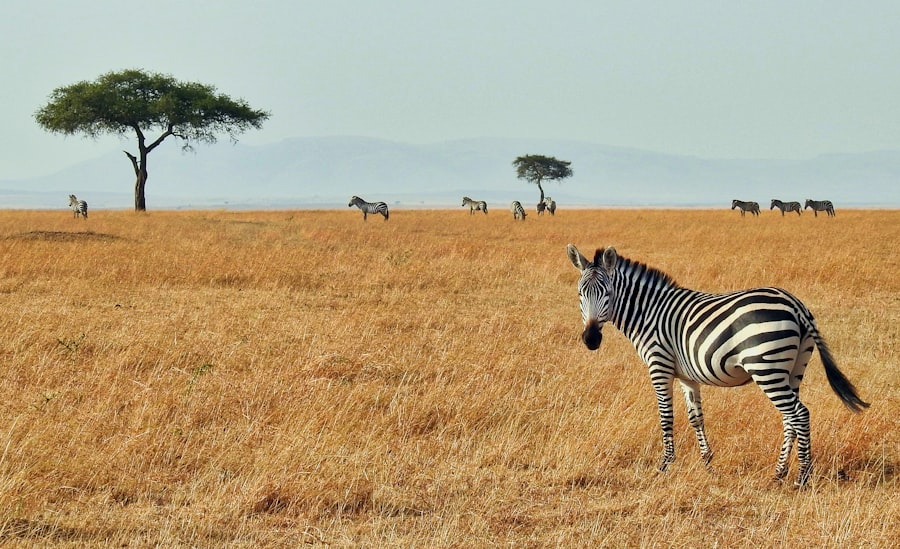In recent years, the concept of virtual wildlife parks has emerged as a groundbreaking approach to conservation and education. These digital environments allow users to explore diverse ecosystems and interact with wildlife in ways that were previously unimaginable. By leveraging advanced technologies such as virtual reality (VR), augmented reality (AR), and immersive simulations, virtual wildlife parks provide an engaging platform for individuals to learn about biodiversity, conservation efforts, and the challenges facing various species.
This innovative approach not only enhances the educational experience but also fosters a deeper emotional connection between users and the natural world. The rise of virtual wildlife parks is particularly significant in an era where traditional methods of wildlife education and conservation are often limited by geographical, financial, or logistical constraints.
As technology continues to evolve, the potential for virtual wildlife parks to play a pivotal role in conservation education and awareness becomes increasingly apparent.
Key Takeaways
- Virtual wildlife parks offer a unique and immersive way to experience and learn about wildlife conservation from anywhere in the world.
- Virtual reality plays a crucial role in conservation education by providing a realistic and interactive experience that can inspire and educate people about the importance of wildlife conservation.
- Advantages of virtual wildlife parks include the ability to reach a wider audience, reduce the impact on natural habitats, and provide a safe environment for endangered species.
- Virtual wildlife parks have a significant impact on engaging younger generations by using technology and interactive experiences to create a sense of connection and responsibility towards wildlife conservation.
- Collaborations between virtual wildlife parks and conservation organizations are essential for creating accurate and impactful educational content, as well as for raising awareness and funds for conservation efforts.
- Virtual wildlife parks serve as a powerful tool for advocacy and fundraising by creating emotional connections and inspiring action towards wildlife conservation.
- Challenges and limitations of virtual wildlife parks in conservation education include the need for access to technology, potential disconnect from the natural world, and limitations in replicating real-life experiences.
- The future of virtual wildlife parks in promoting conservation awareness looks promising, with advancements in technology and increasing global connectivity offering new opportunities for impactful conservation education and advocacy.
The Role of Virtual Reality in Conservation Education
Virtual reality serves as a powerful tool in conservation education by creating immersive experiences that captivate users’ attention and stimulate their curiosity. Unlike traditional educational methods that often rely on textbooks or static images, VR allows individuals to step into a 3D environment where they can observe animals in their natural habitats, interact with them, and even participate in conservation activities. This level of engagement can lead to a more profound understanding of ecological systems and the importance of preserving them.
For instance, a virtual reality experience might allow users to dive into the Great Barrier Reef, witnessing firsthand the vibrant marine life that inhabits this UNESCO World Heritage site. Users can explore coral reefs, observe fish behavior, and learn about the threats posed by climate change and pollution. By experiencing these environments virtually, individuals are more likely to develop empathy for the creatures they encounter and recognize the urgency of conservation efforts.
This emotional connection is crucial for fostering a sense of responsibility toward protecting our planet’s biodiversity.
Advantages of Virtual Wildlife Parks in Promoting Conservation Awareness
One of the most significant advantages of virtual wildlife parks is their ability to reach a global audience without the barriers associated with physical travel. Individuals from diverse backgrounds and locations can access these digital parks, allowing for a broader dissemination of conservation messages. This democratization of access means that people who may never have the opportunity to visit a real wildlife park or natural reserve can still engage with wildlife and learn about conservation issues.
Moreover, virtual wildlife parks can be tailored to suit various educational needs and age groups. Interactive elements such as quizzes, games, and guided tours can be incorporated into the experience, making learning both fun and informative. For example, a virtual park might include a scavenger hunt where users must find specific animals or plants while learning about their roles in the ecosystem.
This gamification of education not only enhances retention but also encourages users to share their experiences with others, further amplifying the reach of conservation awareness.
The Impact of Virtual Wildlife Parks on Engaging Younger Generations
Younger generations are often more attuned to technology than previous ones, making virtual wildlife parks an ideal medium for engaging them in conservation efforts. By utilizing platforms that resonate with their interests—such as gaming, social media, and interactive storytelling—these parks can capture the attention of youth who might otherwise be indifferent to environmental issues. The immersive nature of virtual experiences allows young people to explore complex ecological concepts in an engaging manner that traditional educational methods may fail to achieve.
For instance, a virtual wildlife park could feature a storyline where users take on the role of a wildlife ranger tasked with protecting endangered species from poachers or habitat destruction. This narrative-driven approach not only entertains but also educates users about real-world challenges faced by wildlife conservationists. By placing young individuals in active roles within these narratives, virtual wildlife parks empower them to think critically about environmental issues and consider their potential impact on the world around them.
Collaborations between Virtual Wildlife Parks and Conservation Organizations
The effectiveness of virtual wildlife parks is often amplified through collaborations with established conservation organizations. By partnering with NGOs, research institutions, and governmental bodies, these digital parks can ensure that their content is accurate, relevant, and aligned with ongoing conservation efforts. Such collaborations can also provide valuable resources for developing educational materials and outreach programs that enhance user engagement.
For example, a virtual wildlife park might collaborate with an organization focused on elephant conservation to create an interactive experience that highlights the plight of these majestic creatures. Users could learn about the threats elephants face due to poaching and habitat loss while participating in virtual initiatives aimed at protecting them. This partnership not only enriches the educational content but also helps raise awareness about specific conservation campaigns, encouraging users to take action in support of these causes.
Virtual Wildlife Parks as a Tool for Advocacy and Fundraising
Inspiring Conservation Efforts
By showcasing the beauty and diversity of wildlife, these digital environments can inspire users to support conservation efforts financially or by volunteering their time. Many parks incorporate features that allow users to donate directly to specific projects or organizations dedicated to protecting endangered species or restoring habitats.
Seamless Integration of Advocacy
For instance, a user exploring a virtual rainforest might come across an option to contribute to reforestation efforts or support anti-poaching patrols in real-time. This seamless integration of advocacy within the virtual experience not only raises funds but also cultivates a sense of community among users who share a passion for conservation.
Amplifying Global Conservation Efforts
By fostering connections between individuals and organizations working toward similar goals, virtual wildlife parks can significantly impact global conservation efforts.
Challenges and Limitations of Virtual Wildlife Parks in Conservation Education
Despite their many advantages, virtual wildlife parks are not without challenges and limitations. One significant concern is the potential for oversimplification of complex ecological issues. While immersive experiences can engage users effectively, they may also risk presenting information in a way that lacks nuance or depth.
For instance, a user might come away from a virtual experience believing that a single solution exists for multifaceted problems like climate change or habitat destruction. Additionally, there is the issue of accessibility; while virtual wildlife parks can reach a global audience, not everyone has access to the necessary technology or high-speed internet required for an optimal experience. This digital divide can exacerbate existing inequalities in environmental education and awareness.
Furthermore, there is always the risk that users may become desensitized to environmental issues if they are presented solely through a digital lens without real-world context or action steps.
The Future of Virtual Wildlife Parks in Promoting Conservation Awareness
Looking ahead, the future of virtual wildlife parks appears promising as technology continues to advance and public interest in conservation grows. Innovations such as artificial intelligence (AI) could enhance user experiences by personalizing content based on individual preferences or learning styles. Additionally, as VR technology becomes more affordable and widespread, it is likely that more people will have access to these immersive experiences.
Moreover, as environmental challenges become increasingly urgent, the role of virtual wildlife parks in promoting conservation awareness will likely expand. They could serve as hubs for community engagement, where users not only learn about wildlife but also connect with local conservation initiatives and participate in real-world actions. By fostering a sense of global citizenship and responsibility toward nature, virtual wildlife parks have the potential to inspire a new generation of advocates dedicated to preserving our planet’s rich biodiversity for years to come.
In addition to exploring how virtual wildlife parks are promoting conservation awareness, you may also be interested in learning about the best free software for translation available today. This article provides valuable information on tools that can help bridge language barriers and facilitate communication across cultures. Check it out




